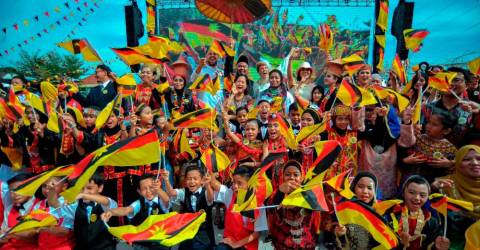SIBU: Sarawak Day every July 22 should be cherished because this date in 1963 marked the end of 122 years of rule by outsiders and the start of self-governance.
This year, Sibu has been given the honour of hosting the 59th anniversary celebration and Tamin assemblyman, Christopher Gira Sambang, is feeling excited like many others here.
“We should celebrate the occasion together so that future generations will continue observing this special day,” he said.
It is appropriate for him to say this as Sarawak has seen much change and growth, especially after the communist insurgency came to an end following the surrender of the North Kalimantan Communist Party (NKCP) led by Ang Cho Teng and signing of a peace agreement on Oct 17, 1990.
Christopher said the ruling Gabungan Parti Sarawak (GPS) under Premier Tan Sri Abang Johari Tun Openg aims to make Sarawak a developed state with average household income increased to RM16,000 per month by 2030.
In order to achieve this, a sense of belonging must be instilled to preserve harmony and unity, as well as protect Sarawak’s interests, he said.
While to become a developed state, Sarawak needs to nurture educated and capable people said Sibu Municipal Council (MPS) member, Sammy Ngelambai.
“For that, Sarawak has its own university. The University of Technology Sarawak (UTS), strategically located in Sibu — Sarawak’s central region — is accessible from any part of the state,” he said.
With a university on its doorstep, more students from the coastal and interior areas especially have a better chance of a brighter future.
“Additionally, the government assists students through the UTS Foundation Scholarship, UTS Bursary Scheme and UTS Undergraduate and Postgraduate Scholarship,” he said.
Sammy said it costs the state government up to RM27 million annually to make education accessible and affordable, and this fruit of independence should not be taken for granted.
Another MPS member, Augustine Merikan, said the building of roads has opened up many opportunities for rural communities to participate in economic activities.
The Kapit township, Song, Dap and Kanowit bazaars along the Rajang River are seeing the positive effects of the Sibu-Kapit road, with people finding it hard to find a parking space in normal circumstances even.
People come to either sell their farm produce at the tamu (market) or enjoy a plate of kampua mee with kopi peng.
“There is no time constraint like before when their only means of travel was by express boat. It has enabled them to send their farm or jungle produce to Sibu,” said Augustine, while adding that the Ibans have started opening up businesses like the Chinese and Malay/Melanau communities, too.
He said that once the Pan Borneo Highway is ready, there will be even more opportunities for Sarawakians to generate income.
“Many things have changed since July 22, 1963. Let’s move together towards 2030. A better future awaits us,” he said.-Bernama
